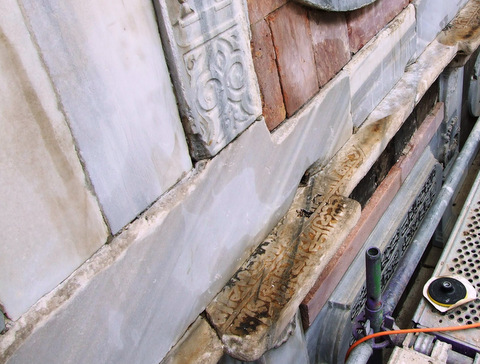(Communicated by the Ministry of Tourism / Israel Antiquities Authority)
As part of a major decade-long renovations program in the old city of Jaffa to improve infrastructure and restore ancient sites for the benefit of tourists and locals alike, an ancient inscription dating to the 14th century was recently discovered that hints at the existence of a previously unknown magnificent mosque.
The inscription was discovered during restoration work on a sebil (a public water fountain found in regional Muslim architecture) dating to the Mamluk period (second half of 13th century until 1516). The fountain is located next to the wall of the Mahmoudiya Mosque on the city's Ruslan Street.
The restoration project of the sebil, which was originally for visitors entering the walled city, is a joint initiative of the Tel Aviv-Jaffa Municipality, the Tourism Ministry and the Israel Antiquities Authority. The inscription was discovered on a marble slab that experts believe was not originally designated for the sebil, but used in its construction. The slab was placed upside down and high up, making it impossible to read the inscription from street level. Additionally, the original slab was sawed into bits with parts of it mixed into different layers of the construction.
 Copyright: Israel Antiquities Authority
Copyright: Israel Antiquities AuthorityThe Arabic writing, deciphered with the assistance of Hebrew University Prof. Moshe Sharon, an expert in Islamic history and Arabic inscriptions, refers to the establishment of a magnificent mosque by a local government official during the reign of the Mamluk Sultan Al-Malik Az-Zahir Sayf ad-Din Barquq, who ruled the land between 1382 and 1399.
Archaeologists are unable to identify the identity or place of the mosque mentioned in the inscription. According to Israel Antiquities Authority archaeologist Yoav Arbel, the mosque was not even located in Jaffa: "Toward the latter part of the 14th century Jaffa wasn't even an inhabited city. The likelihood is slim that the mosque in question was within city limits. Historical sources state that the majority of the marble items and large construction stones for rebuilding the city after Napoleon's retreat were brought by [19th century Ottoman governor] Abu Nabbut from the ruins of Caesarea and Ashkelon, but these cities were also destroyed by the Mamluks more than 100 years before the reign of Barquq. The possibility that a 'magnificent mosque' was established in one of them isn't likely."
 The sebil in Jaffa (Copyright: Nicky Davidov, Courtesy Israel Antiquities Authority)
The sebil in Jaffa (Copyright: Nicky Davidov, Courtesy Israel Antiquities Authority)Restoration of the sebil is slated for completion in July 2013. The fountain is situated on Ruslan Street, which has been renovated, with new infrastructure, paved sidewalks and the restoration of the old city walls running alongside the street.